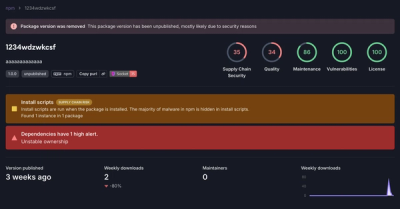
Research
Security News
Threat Actor Exposes Playbook for Exploiting npm to Build Blockchain-Powered Botnets
A threat actor's playbook for exploiting the npm ecosystem was exposed on the dark web, detailing how to build a blockchain-powered botnet.
A hack to put Graphviz on the web. You should probably check out dagre, though:
https://github.com/cpettitt/dagre
https://github.com/cpettitt/dagre-d3
To render as SVG (produces an XML string):
svg = Viz("digraph { a -> b; }", "svg");
See examples here:
http://mdaines.github.io/viz.js/example.html
http://mdaines.github.io/viz.js/form.html
Compiled versions are available on the releases page:
https://github.com/mdaines/viz.js/releases
This project is based on work by Satoshi Ueyama and Brenton Partridge:
https://github.com/gyuque/livizjs
https://github.com/bpartridge/graphviz.js
Thanks to the following contributors:
jbogard
KylePDavis
siefkenj
srathbun
vmarkovtsev
Viz(src, format="svg", engine="dot", options=null)
FAQs
A hack to put Graphviz on the web.
The npm package viz.js receives a total of 60,689 weekly downloads. As such, viz.js popularity was classified as popular.
We found that viz.js demonstrated a not healthy version release cadence and project activity because the last version was released a year ago. It has 2 open source maintainers collaborating on the project.
Did you know?

Socket for GitHub automatically highlights issues in each pull request and monitors the health of all your open source dependencies. Discover the contents of your packages and block harmful activity before you install or update your dependencies.

Research
Security News
A threat actor's playbook for exploiting the npm ecosystem was exposed on the dark web, detailing how to build a blockchain-powered botnet.

Security News
NVD’s backlog surpasses 20,000 CVEs as analysis slows and NIST announces new system updates to address ongoing delays.

Security News
Research
A malicious npm package disguised as a WhatsApp client is exploiting authentication flows with a remote kill switch to exfiltrate data and destroy files.